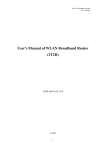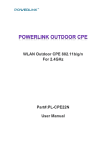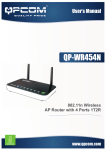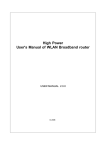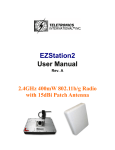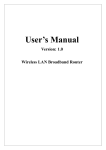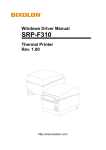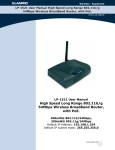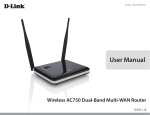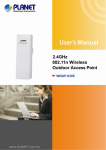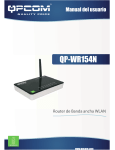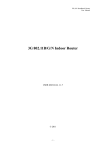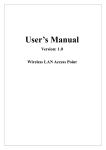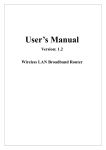Download User`s Manual of WLAN Broadband Router (1T1R)
Transcript
WLAN Broadband Router User Manual User's Manual of WLAN Broadband Router (1T1R) USER MANUAL 2.0.0 © 2009 -1- WLAN Broadband Router User Manual Table of Contents 1. 2. Terminology..........................................................................................................5 Introduction..........................................................................................................7 2.1 Package contents....................................................................................7 2.2 Product Specifications ...........................................................................7 2.3 Product Features.....................................................................................8 2.4 Front Panel Description .........................................................................9 2.5 Rear Panel Description ........................................................................10 3. Installation ..........................................................................................................10 3.1 Hardware Installation...........................................................................10 3.2 Software Installation ............................................................................11 4. Software configuration ...................................................................................... 11 4.1 Prepare your PC to configure the WLAN Broadband Router .............11 4.2 4.3 Connect to the WLAN Broadband Router...........................................12 Management and configuration on the WLAN Broadband Router .....13 4.3.1 Setup Wizard................................................................................13 4.3.2 Operation Mode ...........................................................................18 4.3.3 Wireless........................................................................................19 4.3.3.1 Basic Settings........................................................................19 4.3.3.2 Advanced Settings ................................................................21 4.3.3.3 Security .................................................................................22 4.3.3.3.1 Disable .......................................................................22 4.3.3.3.2 WEP ...........................................................................23 4.3.3.3.3 WPA ...........................................................................24 4.3.3.3.4 WPA2 .........................................................................25 4.3.3.3.5 WPA-Mixed ...............................................................26 4.3.3.4 Access Control ......................................................................28 4.3.3.5 WDS Settings........................................................................29 4.3.3.5.1 WDS Security Setup ..................................................30 4.3.3.5.2 WDS AP Table ...........................................................30 4.3.3.5.3 Mesh settings .............................................................31 4.3.3.6 Site Survey ............................................................................32 4.3.3.7 WPS ......................................................................................33 4.3.3.8 Schedule................................................................................34 4.3.4 TCP/IP Settings............................................................................35 4.3.4.1 LAN Interface Setup .............................................................35 4.3.4.1.1 Static DHCP Setup.....................................................37 -2- WLAN Broadband Router User Manual 4.3.4.2 WAN Interface Setup ............................................................39 4.3.4.2.1 Static IP......................................................................39 4.3.4.2.2 DHCP Client ..............................................................41 4.3.4.2.3 PPPoE ........................................................................43 4.3.4.2.4 PPTP ..........................................................................45 4.3.4.2.5 L2TP ..........................................................................47 4.3.5 Firewall ........................................................................................49 4.3.5.1 Port Filtering .........................................................................49 4.3.5.2 IP Filtering ............................................................................50 4.3.5.3 MAC Filtering.......................................................................51 4.3.5.4 Port Forwarding ....................................................................52 4.3.5.5 URL Filtering........................................................................53 4.3.5.6 DMZ......................................................................................54 4.3.5.7 VLAN ...................................................................................55 4.3.6 4.3.7 QoS ..............................................................................................56 Management.................................................................................58 4.3.7.1 Status.....................................................................................58 4.3.7.2 Statistics ................................................................................60 4.3.7.3 DDNS....................................................................................61 4.3.7.4 Time Zone Setting.................................................................62 4.3.7.5 Denial-of-Service..................................................................63 4.3.7.6 Log ........................................................................................64 4.3.7.7 Upgrade Firmware ................................................................65 4.3.7.8 Save/ Reload Settings ...........................................................65 4.3.7.9 Password ...............................................................................66 5. FREQUENTLY ASKED QUESTIONS (FAQ)................................................67 5.1 What and how to find my PC’s IP and MAC address?........................67 5.2 What is Wireless LAN? .......................................................................67 5.3 5.4 5.5 5.6 5.7 5.8 5.9 5.10 5.11 5.12 What are ISM bands?...........................................................................67 How does wireless networking work? .................................................67 What is BSSID? ...................................................................................68 What is ESSID?. ..................................................................................68 What are potential factors that may causes interference?....................68 What are the Open System and Shared Key authentications? .............68 What is WEP? ......................................................................................68 What is Fragment Threshold? ..............................................................69 What is RTS (Request To Send) Threshold?........................................69 What is Beacon Interval? .....................................................................69 -3- WLAN Broadband Router User Manual 6. 5.13 5.14 5.15 5.16 5.17 5.18 5.19 5.20 5.21 5.22 5.23 5.24 5.25 5.26 What is Preamble Type? ......................................................................69 What is SSID Broadcast?.....................................................................69 What is Wi-Fi Protected Access (WPA)?.............................................70 What is WPA2? ....................................................................................70 What is 802.1x Authentication?...........................................................70 What is Temporal Key Integrity Protocol (TKIP)?..............................70 What is Advanced Encryption Standard (AES)? .................................70 What is Inter-Access Point Protocol (IAPP)? ......................................70 What is Wireless Distribution System (WDS)? ...................................70 What is Universal Plug and Play (uPNP)?...........................................70 What is Maximum Transmission Unit (MTU) Size?...........................71 What is Clone MAC Address?.............................................................71 What is DDNS?....................................................................................71 What is NTP Client? ............................................................................71 5.27 5.28 5.29 5.30 5.31 5.32 5.33 5.34 What is VPN? ......................................................................................71 What is IPSEC?....................................................................................71 What is WLAN Block Relay Between Clients? ..................................71 What is WMM?....................................................................................71 What is WLAN ACK TIMEOUT? ......................................................71 What is Modulation Coding Scheme (MCS)? .....................................71 What is Frame Aggregation? ...............................................................72 What is Guard Intervals (GI)?..............................................................72 Configuration examples.....................................................................................73 6.1 Example one -PPPoE on the WAN ......................................................73 6.2 Example two -fixed IP on the WAN ....................................................77 -4- WLAN Broadband Router User Manual 1. Terminology 3DES Triple Data Encryption Standard AES Advanced Encryption Standard ANSI American National Standards Institute AP Access Point CCK Complementary Code Keying CSMA/CA Carrier Sense Multiple Access/Collision Avoidance CSMA/CD Carrier Sense Multiple Access/Collision Detection DDNS Dynamic Domain Name Server DH Diffie-Hellman Algorithm DHCP Dynamic Host Configuration Protocol DSSS Direct Sequence Spread Spectrum EAP Extensible Authentication Protocol ESP Encapsulating Security Payload FCC Federal Communications Commission FTP File Transfer Protocol IEEE Institute of Electrical and Electronic Engineers IKE Internet Key Exchange IP Internet Protocol ISM Industrial, Scientific and Medical LAN Local Area Network MAC Media Access Control MD5 Message Digest 5 NAT Network Address Translation NT Network Termination NTP Network Time Protocol PPTP Point to Point Tunneling Protocol PSD Power Spectral Density RF Radio Frequency SHA1 Secure Hash Algorithm SNR Signal to Noise Ratio SSID Service Set Identification TCP Transmission Control Protocol JTFTP Trivial File Transfer Protocol -5- WLAN Broadband Router User Manual TKIP Temporal Key Integrity Protocol UPNP Universal Plug and Play VPN Virtual Private Network WDS Wireless Distribution System WEP Wired Equivalent Privacy WLAN Wireless Local Area Network WPA Wi-Fi Protected Access -6- WLAN Broadband Router User Manual 2. Introduction The Wireless LAN Broadband Router is an affordable IEEE 802.11b/g with 802.11n specifications of wireless LAN broadband router solution; setting SOHO and enterprise standard for high performance, secure, manageable and reliable WLAN. This document describes the steps required for the initial IP address assign and other WLAN router configuration. The description includes the implementation of the above steps. 2.1 Package contents The package of the WLAN Broadband Router includes the following items, 9 The WLAN Broadband Router 9 The DC Power Adapter 9 The Documentation CD 9 RJ-45 Cable Line 9 Cradle 9 The One panel antenna 2.2 Product Specifications Product Name WLAN 11n Router, 2.4G Standard 802.11b/g/n(Wireless), 802.3(10BaseT), 802.3u(100BaseT) Data Transfer Rate 1,2,5.5,6,9,11,12,18,24,36,48,54, and maximum of 150Mbps Modulation Method BPSK/QPSK/16-QAM/64-QAM Frequency Band 2.4GHz -2.483GJz ISM Band RF Output Power < 22dBm(802.11n),< 24dBm(802.11b),< 28dBm(802.11g) Receiver Sensitivity 802.11b: -93dBm@8%, 802.11g: -91dBm@10%, 802.11n: -89dBm@10% Operation Range Indoor@Up to 100 meters,Outdoor@Up to 280 meters Antenna External Antenna(1Tx1R) LED Power, Active (WLAN), Act/Link (Ethernet) Security 64 bit/128 bit WEP, TKIP, AES LAN interface One 10/100BaseT with RJ45 connector (WAN) Four 10/100BaseT with RJ45 connectors (LAN) Power Consumption 12 V, 1A Power Adapter Operating Temperature 0 ~ 50°C ambient temperature Storage Temperature -20 ~ 70°C ambient temperature Humidity 5 to 90 % maximum (non-condensing) Dimension 149 x 104 x 25 mm -7- WLAN Broadband Router User Manual 2.3 Product Features Generic Router ¾ Compatible with IEEE 802.11n Specifications provides wireless speed up to 150Mbps data rate. ¾ Compatible with IEEE 802.11g high rate standard to provide wireless Ethernet speeds of 54Mbps data rate. ¾ Maximizes the performance and ideal for media-centric applications like streaming video, gaming and Voice over IP technology. ¾ Supports multi-operation (bridge/gateway/WISP) modes between wireless and wired Ethernet interfaces. ¾ Supports WPS, 64-bit and 128-bit WEP, WPA, WPA2 encryption/decryption and WPA with Radius function to protect the wireless data transmission. ¾ Supports IEEE 802.1x Authentication. ¾ Supports IEEE 802.3x full duplex flow control on 10/100M Ethernet interface. ¾ Supports DHCP server to provide clients auto IP addresses assignment. ¾ Supports DHCP client, static IP, PPPoE, PPTP of WAN Interface. ¾ Supports firewall security with port filtering, IP filtering, MAC filtering, port forwarding, trigger port, DMZ hosting and URL filtering functions. ¾ Supports WEB based management and configuration. ¾ Supports UPnP for automatic Internet access. ¾ Supports Dynamic DNS service. ¾ Supports NTP client service. ¾ Supports Log table and remote Log service. ¾ Support Setup Wizard mode. ¾ Support QoS for uplink and downlink ¾ Support Wireless Mesh Networking setting ¾ Support VLAN tagging -8- WLAN Broadband Router User Manual 2.4 Front Panel Description LED Indicator 1. PWR LED 2. WLAN LED State on The WLAN Broadband Router is powered on. off The WLAN Broadband Router is powered off. Flashing Data is transmitting or receiving on the antenna. off Flashing 3. LAN LED ACT No data is transmitting or receiving on the antenna. Data is transmitting or receiving on the LAN interface. on Port linked. off No link. Flashing 4. WAN LED ACT Description Data is transmitting or receiving on the WAN interface. on Port linked. off No link. Flashing 1sec flash light /1sec light dark / attempt to communicate with wireless client 5. WPS LED ACT on When user press WPS button off Default No link -9- WLAN Broadband Router User Manual 2.5 Rear Panel Description Interfaces Description Antenna (Fixed / SMA) The Wireless LAN Antenna. Power The power jack allows an external DC power supply connection. The external DC adaptor provide adaptive power requirement to the WLAN Broadband Router. LAN The RJ-45 sockets allow LAN connection through Category 5 cables. Support auto-sensing on 10/100M speed and half/ full duplex; comply with IEEE 802.3/ 802.3u respectively. WAN The RJ-45 socket allows WAN connection through a Category 5 cable. Support auto-sensing on 10/100M speed and half/ full duplex; comply with IEEE 802.3/ 802.3u respectively. Reset Push continually the reset button 5 ~ 10 seconds to reset the configuration parameters to factory defaults. WPS Push the WPS button implementation to reduce the network configuration steps,and also easy to implement network security. 3. Installation 3.1 Hardware Installation Step 1: Place the WLAN Broadband Router to the best optimum transmission location. The best transmission location for your WLAN Broadband Router is usually at the geographic center of your wireless network, with line of sign to all of your mobile stations. Step 2: Connect the WLAN Broadband Router to your wired network. Connect the Ethernet WAN interface of WLAN Broadband Router by category 5 Ethernet cable to your switch/ hub/ xDSL modem or cable modem. A straight-through Ethernet cable with appropriate cable length is needed. Step 3: Plug in the DC power to the WLAN Broadband Router. Use only the AC/DC power adapter supplied with the WLAN Broadband Router; it maybe occur damage by using a different type of power adapter. The hardware installation finished. - 10 - WLAN Broadband Router User Manual 3.2 Software Installation There are no software drivers or utilities installation needed, but only the configuration setting. Please refer to chapter 4 for software configuration. Notice: It will take about 50 seconds to complete the boot up sequence after powered on the WLAN Broadband Router; Power LED will be active, and after that the WLAN Activity LED will be flashing to show the WLAN interface is enabled and working now. 4. Software configuration There are web based management and configuration functions allowing you to have the jobs done easily. The WLAN Broadband Router is delivered with the following factory default parameters on the Ethernet LAN interfaces. Default IP Address: 192.168.1.254 Default IP subnet mask: 255.255.255.0 WEB login User Name: <empty> WEB login Password: <empty> 4.1 Prepare your PC to configure the WLAN Broadband Router For OS of Microsoft Windows 2000/ XP: 1. 2. 3. 4. 5. 6. 7. 8. Click the Start button and select Settings, then click Control Panel. The Control Panel window will appear. Move mouse and double-click the right button on Network and Dial-up Connections icon. Move mouse and double-click the Local Area Connection icon. The Local Area Connection window will appear. Click Properties button in the Local Area Connection window. Check the installed list of Network Components. If TCP/IP is not installed, click the Add button to install it; otherwise go to step 6. Select Protocol in the Network Component Type dialog box and click Add button. Select TCP/IP in Microsoft of Select Network Protocol dialog box then click OK button to install the TCP/IP protocol, it may need the Microsoft Windows CD to complete the installation. Close and go back to Network dialog box after the TCP/IP installation. Select TCP/IP and click the properties button on the Network dialog box. Select Specify an IP address and type in values as following example. 9 IP Address: 192.168.1.1, any IP address within 192.168.1.1 to 192.168.1.253 is good to connect the Wireless LAN Access Point. 9 IP Subnet Mask: 255.255.255.0 Click OK to completes the IP parameters setting. For OS of Microsoft Windows Vista / 7: 1. 2. 3. 4. 5. Click the Start button and select Settings, then click Control Panel. The Control Panel window will appear. Move mouse and double-click the right button on Network Connections item. The Network Connections window will appear. Double click Local Area Connection icon, then User Account Control window shown. Right click Continue button to set properties. In Local Area Connection Properties window, Choose Networking tab, move mouse and click Internet Protocol Version 4 (TCP/IPv4), then click Properties button. Move mouse and click General tab, Select Specify an IP address and type in values as following example. 9 IP Address: 192.168.1.1, any IP address within 192.168.1.1 to 192.168.1.253 is good to connect the Wireless LAN Access Point. 9 IP Subnet Mask: 255.255.255.0 Click OK to complete the IP parameters setting. - 11 - WLAN Broadband Router User Manual For OS of Microsoft Windows 95/ 98/ Me: 1. Click the Start button and select Settings, then click Control Panel. The Control Panel window will appear. Note: Windows Me users may not see the Network control panel. If so, select View all Control Panel options on the left side of the window 2. Move mouse and double-click the right button on Network icon. The Network window will appear. 3. Check the installed list of Network Components. If TCP/IP is not installed, click the Add button to install it; otherwise go to step 6. 4. Select Protocol in the Network Component Type dialog box and click Add button. 5. Select TCP/IP in Microsoft of Select Network Protocol dialog box then click OK button to install the TCP/IP protocol, it may need the Microsoft Windows CD to complete the installation. Close and go back to Network dialog box after the TCP/IP installation. 6. Select TCP/IP and click the properties button on the Network dialog box. 7. Select Specify an IP address and type in values as following example. 9 IP Address: 192.168.1.1, any IP address within 192.168.1.1 to 192.168.1.253 is good to connect the Wireless LAN Access Point. 9 IP Subnet Mask: 255.255.255.0 8. Click OK and reboot your PC after completes the IP parameters setting. For OS of Microsoft Windows NT: 1. Click the Start button and select Settings, then click Control Panel. The Control Panel window will appear. 2. Move mouse and double-click the right button on Network icon. The Network window will appear. Click Protocol tab from the Network window. 3. Check the installed list of Network Protocol window. If TCP/IP is not installed, click the Add 4. 5. 6. 7. 8. 4.2 button to install it; otherwise go to step 6. Select Protocol in the Network Component Type dialog box and click Add button. Select TCP/IP in Microsoft of Select Network Protocol dialog box then click OK button to install the TCP/IP protocol, it may need the Microsoft Windows CD to complete the installation. Close and go back to Network dialog box after the TCP/IP installation. Select TCP/IP and click the properties button on the Network dialog box. Select Specify an IP address and type in values as following example. 9 IP Address: 192.168.1.1, any IP address within 192.168.1.1 to 192.168.1.253 is good to connect the Wireless LAN Access Point. 9 IP Subnet Mask: 255.255.255.0 Click OK to complete the IP parameters setting. Connect to the WLAN Broadband Router Open a WEB browser, i.e. Microsoft Internet Explore 6.1 SP1 or above, then enter 192.168.1.254 on the URL to connect the WLAN Broadband Router. - 12 - WLAN Broadband Router User Manual 4.3 Management and configuration on the WLAN Broadband Router 4.3.1 Setup Wizard This page guides you to configure wireless broadband router for first time. I. Operation Mode This page followed by Setup Wizard page to define the operation mode. - 13 - WLAN Broadband Router User Manual II. Time Zone Setting This page is used to enable and configure NTP client. III. LAN Interface Setup This page is used to configure local area network IP address and subnet mask. - 14 - WLAN Broadband Router User Manual IV.WAN Interface Setup This page is used to configure WAN access type. V. Wireless Basic Settings This page is used to configure basic wireless parameters like Band, Mode, Network Type SSID, Channel Number, Enable Mac Clone (Single Ethernet Client). - 15 - WLAN Broadband Router User Manual VI. Wireless Security Setup This page is used to configure wireless security. - 16 - WLAN Broadband Router User Manual - 17 - WLAN Broadband Router User Manual 4.3.2 Operation Mode This page is used to configure which mode wireless broadband router acts. Item Gateway Bridge Wireless ISP Apply Changes Reset Description Traditional gateway configuration. It always connects internet via ADSL/Cable Modem. LAN interface, WAN interface, Wireless interface, NAT and Firewall modules are applied to this mode Each interface (LAN, WAN and Wireless) regards as bridge. NAT, Firewall and all router's functions are not supported Switch Wireless interface to WAN port and all Ethernet ports in bridge mode. Wireless interface can do all router's functions Click the Apply Changes button to complete the new configuration setting. Click the Reset button to abort change and recover the previous configuration setting. - 18 - WLAN Broadband Router User Manual 4.3.3 Wireless 4.3.3.1 Basic Settings This page is used to configure the parameters for wireless LAN clients that may connect to your Broadband Router. Here you may change wireless settings as well as wireless network parameters. Item Description Disable Wireless LAN Interface Click on to disable the wireless LAN data transmission. Band Click to select 2.4GHz(B) / 2.4GHz(G) / 2.4GHz(N) / 2.4GHz(B+G)/ 2.4GHz(G+N) / 2.4GHz(B+G+N) Mode Click to select the WLAN AP / Client / WDS / AP+WDS / AP+MESH / MESH wireless mode. Network Type While Mode is selected to be Client. Click to select the network type infrastructure or Ad hoc. SSID It is the wireless network name. The SSID can be 32 bytes long. Channel Width Select the operating channel width 20 MHz or 40 MHz. [N band only] Control Sideband Select the Sideband with Upper or Lower for channel width 40MHz. [N band only] - 19 - WLAN Broadband Router User Manual Channel Number Select the wireless communication channel from pull-down menu. Broadcast SSID Click to enable or disable the SSID broadcast function. WMM Click Enabled/Disabled to init WMM feature. Data Rate Select the transmission data rate from pull-down menu. Data rate can be auto-select, 1M to 54Mbps or MCS. Associated Clients Click the Show Active Clients button to open Active Wireless Client Table that shows the MAC address, transmit-packet, receive-packet and transmission-rate for each associated wireless client. Enable Mac Clone (Single Ethernet Client) Take Laptop NIC MAC address as wireless client MAC address. [Client Mode only] Enable Universal Repeater Mode Click to enable Universal Repeater Mode SSID of Extended Interface Assign SSID when enables Universal Repeater Mode. Apply Changes Click the Apply Changes button to complete the new configuration setting. Reset Click the Reset button to abort change and recover the previous configuration setting. - 20 - WLAN Broadband Router User Manual 4.3.3.2 Advanced Settings These settings are only for more technically advanced users who have a sufficient knowledge about wireless LAN. These settings should not be changed unless you know what effect the changes will have on your WLAN Broadband Router. Item Description Fragment Threshold Set the data packet fragmentation threshold, value can be written between 256 and 2346 bytes. RTS Threshold Set the RTS Threshold, value can be written between 0 and 2347 bytes. Beacon Interval Set the Beacon Interval, value can be written between 20 and 1024 ms. Preamble Type Click to select the Long Preamble or Short Preamble support on the wireless data packet transmission. IAPP Click to enable or disable the IAPP function. Protection Protect 802.11n user priority. Aggregation Click to enable or disable the Aggregation function. Short GI Click to enable or disable the short Guard Intervals function. WLAN Partition Click to enable or disable the WLAN Partition function. RF Output Power To adjust transmission power level. Apply Changes Click the Apply Changes button to complete the new configuration setting. Reset Click the Reset button to abort change and recover the previous configuration setting. - 21 - WLAN Broadband Router User Manual 4.3.3.3 Security This page allows you setup the wireless security. Turn on WEP, WPA, WPA2 by using encryption keys could prevent any unauthorized access to your wireless network. 4.3.3.3.1 Disable Item Description Select SSID Select the SSID from multiple APs. Disable Select the “Disable” option to disable wireless encryption. Use 802.1x Authentication While Encryption is selected to be WEP. Click the check box to enable IEEE 802.1x authentication function. Apply Changes Click the Apply Changes button to complete the new configuration setting. Reset Click the Reset button to abort change and recover the previous configuration setting. - 22 - WLAN Broadband Router User Manual 4.3.3.3.2 WEP Item Description Select SSID Select the SSID from multiple APs. WEP Select the “WEP” to enable WEP encryption for wireless security. Use 802.1x Authentication While Encryption is selected to be WEP. Click the check box to enable IEEE 802.1x authentication function. Authentication Type Click to select the authentication type in Open System, Shared Key or Auto selection. Key Length Key Format Encryption Key Apply Changes Reset Select the WEP shared secret key length from pull-down menu. The length can be chose between 64-bit and 128-bit (known as “WEP2”) keys. The WEP key is composed of initialization vector (24 bits) and secret key (40-bit or 104-bit). Select the WEP shared secret key format from pull-down menu. The format can be chose between plant text (ASCII) and hexadecimal (HEX) code. Secret key of WEP security encryption function. Click the Apply Changes button to complete the new configuration setting. Click the Reset button to abort change and recover the previous configuration setting. - 23 - WLAN Broadband Router User Manual WEP encryption key (secret key) length: Format Length 64-bit 128-bit ASCII 5 characters 13 characters HEX 10 hexadecimal codes 26 hexadecimal codes 4.3.3.3.3 WPA Item Description Select SSID Select the SSID from multiple APs. WPA Select the “WPA” to enable WPA encryption for wireless security. Authentication Mode While Encryption is selected to be WPA. Click to select the WPA Authentication Mode with Enterprise (RADIUS) or Personal (Pre-Shared Key). WPA Cipher Suite Select the Cipher Suite for WPA encryption. Pre-Shared Key Format While Encryption is selected to be WPA. Select the Pre-shared key format from the pull-down menu. The format can be Passphrase or Hex (64 characters). [WPA, Personal(Pre-Shared Key) only] Pre-Shared Key Fill in the key value. [WPA, Personal(Pre-Shared Key) only] RADIUS Server IP Address RADIUS Server Port RADIUS Server Password Fill in the IP address of RADIUS Server. [WPA, Enterprise(RADIUS) only] Fill in the port number for authentication with RADIUS Server. [WPA, Enterprise(RADIUS) only] Fill in the password for authentication with RADIUS Server. [WPA, Enterprise(RADIUS) only] - 24 - WLAN Broadband Router User Manual Apply Changes Click the Apply Changes button to complete the new configuration setting. Reset Click the Reset button to abort change and recover the previous configuration setting. 4.3.3.3.4 WPA2 Item Description Select SSID Select the SSID from multiple APs. WPA2 Select the “WPA2” to enable WPA2 encryption for wireless security. Authentication Mode While Encryption is selected to be WPA. Click to select the WPA Authentication Mode with Enterprise (RADIUS) or Personal (Pre-Shared Key). WPA2 Cipher Suite Select the Cipher Suite for WPA2 encryption. Pre-Shared Key Format While Encryption is selected to be WPA. Select the Pre-shared key format from the pull-down menu. The format can be Passphrase or Hex (64 characters). [WPA, Personal(Pre-Shared Key) only] Pre-Shared Key Fill in the key value. [WPA, Personal(Pre-Shared Key) only] RADIUS Server IP Address RADIUS Server Port RADIUS Server Password Apply Changes Fill in the IP address of RADIUS Server. [WPA, Enterprise(RADIUS) only] Fill in the port number for authentication with RADIUS Server. [WPA, Enterprise(RADIUS) only] Fill in the password for authentication with RADIUS Server. [WPA, Enterprise(RADIUS) only] Click the Apply Changes button to complete the new configuration setting. - 25 - WLAN Broadband Router User Manual Click the Reset button to abort change and recover the previous configuration setting. Reset 4.3.3.3.5 WPA-Mixed Item Description Select SSID Select the SSID from multiple APs. WPA-Mixed Select the “WPA-Mixed” to enable WPA-Mixed encryption for wireless security. Authentication Mode While Encryption is selected to be WPA. Click to select the WPA Authentication Mode with Enterprise (RADIUS) or Personal (Pre-Shared Key). WPA Cipher Suite Select the Cipher Suite for WPA encryption. WPA2 Cipher Suite Select the Cipher Suite for WPA2 encryption. Pre-Shared Key Format While Encryption is selected to be WPA. Select the Pre-shared key format from the pull-down menu. The format can be Passphrase or Hex (64 characters). [WPA, Personal(Pre-Shared Key) only] Pre-Shared Key Fill in the key value. [WPA, Personal(Pre-Shared Key) only] RADIUS Server IP Address RADIUS Server Port RADIUS Server Password Apply Changes Fill in the IP address of RADIUS Server. [WPA, Enterprise(RADIUS) only] Fill in the port number for authentication with RADIUS Server. [WPA, Enterprise(RADIUS) only] Fill in the password for authentication with RADIUS Server. [WPA, Enterprise(RADIUS) only] Click the Apply Changes button to complete the new configuration setting. - 26 - WLAN Broadband Router User Manual Reset Click the Reset button to abort change and recover the previous configuration setting. - 27 - WLAN Broadband Router User Manual 4.3.3.4 Access Control If you enable wireless access control, only those clients whose wireless MAC addresses are in the access control list will be able to connect to your Access Point. When this option is enabled, no wireless clients will be able to connect if the list contains no entries. Item Description Wireless Access Control Mode Click the Disabled, Allow Listed or Deny Listed of drop down menu choose wireless access control mode. This is a security control function; only those clients registered in the access control list can link to this WLAN Broadband Router. MAC Address Fill in the MAC address of client to register this WLAN Broadband Router access capability. Comment Fill in the comment tag for the registered client. Apply Changes Click the Apply Changes button to complete the new configuration setting. Reset Click the Reset button to abort change and recover the previous configuration setting. Current Access Control List It shows the registered clients that are allowed to link to this WLAN Broadband Router. Delete Selected Click to delete the selected clients that will be access right removed from this WLAN Broadband Router. Delete All Click to delete all the registered clients from the access allowed list. Reset Click the Reset button to abort change and recover the previous configuration setting. - 28 - WLAN Broadband Router User Manual 4.3.3.5 WDS Settings Wireless Distribution System uses wireless media to communicate with other APs, like the Ethernet does. To do this, you must set these APs in the same channel and set MAC address of other AP that you want to communicate with in the table and then enable the WDS. Item Description Enable WDS Click the check box to enable wireless distribution system. MAC Address Fill in the MAC address of AP to register the wireless distribution system access capability. Data Rate Select the transmission data rate from pull-down menu. Data rate can be auto-select, 1M to 54Mbps or MCS. Comment Fill in the comment tag for the registered AP. Apply Changes Click the Apply Changes button to complete the new configuration setting. Reset Set Security Click the Reset button to abort change and recover the previous configuration setting. Click button to configure wireless security like WEP(64bits), WEP(128bits), WPA(TKIP), WPA2(AES) or None Show Statistics It shows the TX, RX packets, rate statistics. Delete Selected Click to delete the selected clients that will be access right removed from this WLAN Broadband Router. Delete All Click to delete all the registered clients from the access allowed list. Reset Click the Reset button to abort change and recover the previous configuration setting. - 29 - WLAN Broadband Router User Manual 4.3.3.5.1 WDS Security Setup Requirement: Set [Wireless]->[Basic Settings]->[Mode]->AP+WDS This page is used to configure the wireless security between APs. 4.3.3.5.2 WDS AP Table This page is used to show WDS statistics. Item Description MAC Address Tx Packets It shows the MAC Address within WDS. It shows the statistic count of sent packets on the wireless LAN interface. It shows the statistic count of error sent packets on the Wireless LAN interface. It shows the statistic count of received packets on the wireless LAN interface. Tx Errors Rx Packets Tx Rare (Mbps) It shows the wireless link rate within WDS. Refresh Click to refresh the statistic counters on the screen. Close Click to close the current window. - 30 - WLAN Broadband Router User Manual 4.3.3.5.3 Mesh settings This page is used to configure Mesh network consisted of two or more mesh points communicating via mesh services. Item Enable Mesh Mesh ID Encryption Pre-Shared Key Format Pre-Shared Key Apply Changes Rest Set Access Control Show Advanced Information Description Clicking the check box and clicking “Apply Changes” will enable Wireless Mesh Network Setting. Mesh is disabled by default. Users should enter the same “Mesh ID” in this text field and then click “Apply Changes” for all the MPs of the same mesh network. Selecting the encryption method “WPA2(AES)” in the pull-down menu and properly configure the two items “Pre-Shared Key Format” and “Pre-Shared Key” below and then click “Apply Changes” can enable the encryption. Please note that all the MPs in the same mesh network should be configured with the same encryption method. There are two options, “Passphrase” and “Hex(64 characters)”, that correspond to the format of pre-shared key entered in the “Pre-Shared Key” text field below. If “Passphrase” is selected, the entered pre-shared key should be any passphrase at least 8 characters long. If the selected format is “Hex(64 characters)”, users should enter 64 hex numbers(0-9 or a-f) in this field. Whenever users want to enable/disable Mesh or change the encryption configurations, they need to apply this button to commit changes. It restores the original values of “Mesh ID”, “Encryption” and “Pre-Shared Key Format” and “ Pre-Shared Key”. It is only used for advanced users to setup the access control rules of MPs. When click the “Set Access Control” button, the “Access Control List for Mesh Network” page is presented. Advanced users could click the “Show Advanced Information” button to access the “Wireless Mesh Network Information” page for detailed information of current mesh network. - 31 - WLAN Broadband Router User Manual 4.3.3.6 Site Survey This page is used to view or configure other APs near yours. Item Description SSID It shows the SSID of AP. BSSID It shows BSSID of AP. Channel It show the current channel of AP occupied. Type It show which type AP acts. Encrypt It shows the encryption status. Signal It shows the power level of current AP. Refresh Click the Refresh button to re-scan site survey on the screen. Connect Click the Connect button to establish connection. - 32 - WLAN Broadband Router User Manual 4.3.3.7 WPS This page allows you to change the setting for WPS (Wi-Fi Protected Setup). Using this feature could let your wireless client automically syncronize its setting and connect to the Access Point in a minute without any hassle. Item Description Disable WPS Click on to disable the Wi-Fi Protected Setup function. WPS Status Show WPS status is Configured or UnConfigured. Rest to UnConfigured Click this button to back to UnConfigured status. Self-PIN Number Fill in the PIN Number of AP to register the wireless distribution system access capability. Push Button Configuration The Start PBC button provides tool to scan the wireless network. If any Access Point or IBSS is found, you could connect it automatically when client join PBC mode. Apply Changes Click the Apply Changes button to complete the new configuration setting. Reset Click the Reset button to abort change and recover the previous configuration setting. Client PIN Number Fill in the Client PIN Number from your Client sites. - 33 - WLAN Broadband Router User Manual 4.3.3.8 Schedule This page is used to configure schedule for enabling wireless function. Item Description Enable Wireless Schedule Click to enable the Wireless Schedule function. Days Select days that you want to enable wireless function. Time Select the time that you want to enable wireless function. Apply Changes Click the Apply Changes button to complete the new configuration setting. Reset Click the Reset button to abort change and recover the previous configuration setting. - 34 - WLAN Broadband Router User Manual 4.3.4 TCP/IP Settings 4.3.4.1 LAN Interface Setup This page is used to configure the parameters for local area network that connects to the LAN ports of your WLAN Broadband Router. Here you may change the setting for IP address, subnet mask, DHCP, etc. Item Description IP Address Fill in the IP address of LAN interfaces of this WLAN Access Point. Subnet Mask Fill in the subnet mask of LAN interfaces of this WLAN Access Point. Default Gateway Fill in the default gateway for LAN interfaces out going data packets. DHCP Click to select Disabled, Client or Server in different operation mode of wireless Access Point. DHCP Client Range Fill in the start IP address and end IP address to allocate a range of IP addresses; client with DHCP function set will be assigned an IP address from the range. Show Client Click to open the Active DHCP Client Table window that shows the active clients with their assigned IP address, MAC address and time expired information. [Server mode only] - 35 - WLAN Broadband Router User Manual Set Static DHCP Manual setup Static DHCP IP address for specific MAC address. [Server mode only] Domain Name Assign Domain Name and dispatch to DHCP clients. It is optional field. 802.1d Spanning Tree Select enable or disable the IEEE 802.1d Spanning Tree function from pull-down menu. Clone MAC Address Fill in the MAC address that is the MAC address to be cloned Apply Changes Click the Apply Changes button to complete the new configuration setting. Reset Click the Reset button to abort change and recover the previous configuration setting. - 36 - WLAN Broadband Router User Manual 4.3.4.1.1 Static DHCP Setup Item Description Enable Static DHCP Click the box to enable static DHCP function. IP Address If you select the Set Static DHCP on LAN interface, fill in the IP address for it. MAC Address If you select the Set Static DHCP on LAN interface, fill in the MAC address for it. Comment Fill in the comment tag for the registered Static DHCP. Apply Changes Click the Apply Changes button to complete the new configuration setting. Reset Click the Reset button to abort change and recover the previous configuration setting. Static DHCP List It shows IP Address MAC Address from the Static DHCP. Delete Selected Click to delete the selected clients that will be removed from the Static DHCP list. Delete All Click to delete all the registered clients from the Static DHCP list. Reset Click the Reset button to abort change and recover the previous configuration setting. - 37 - WLAN Broadband Router User Manual - 38 - WLAN Broadband Router User Manual 4.3.4.2 WAN Interface Setup This page is used to configure the parameters for wide area network that connects to the WAN port of your WLAN Broadband Router. Here you may change the access method to Static IP, DHCP, PPPoE or PPTP by click the item value of WAN Access Type. 4.3.4.2.1 Static IP Item Description Static IP Click to select Static IP support on WAN interface. There are IP address, subnet mask and default gateway settings need to be done. IP Address If you select the Static IP support on WAN interface, fill in the IP address for it. - 39 - WLAN Broadband Router User Manual Subnet Mask If you select the Static IP support on WAN interface, fill in the subnet mask for it. Default Gateway If you select the Static IP support on WAN interface, fill in the default gateway for WAN interface out going data packets. MTU Size Fill in the mtu size of MTU Size. DNS 1 Fill in the IP address of Domain Name Server 1. DNS 2 Fill in the IP address of Domain Name Server 2. DNS 3 Fill in the IP address of Domain Name Server 3. Clone MAC Address Fill in the MAC address that is the MAC address to be cloned. Enable uPNP Click the checkbox to enable uPNP function. Enable IGMP Proxy Click the checkbox to enable IGMP Proxy. Enable Ping Access on WAN Click the checkbox to enable WAN ICMP response. Enable Web Server Access on WAN Click the checkbox to enable web configuration from WAN side. Enable IPsec pass through on VPN connection Click the checkbox to enable IPSec packet pass through. Enable PPTP pass through on VPN connection Click the checkbox to enable PPTP packet pass through. Enable L2TP pass through on VPN connection Click the checkbox to enable L2TP packet pass through. Apply Changes Click the Apply Changes button to complete the new configuration setting. Reset Click the Reset button to abort change and recover the previous configuration setting. - 40 - WLAN Broadband Router User Manual 4.3.4.2.2 DHCP Client Item Description DHCP Client Click to select DHCP support on WAN interface for IP address assigned automatically from a DHCP server. Host Name Fill in the host name of Host Name. The default value is empty. MTU Size Fill in the mtu size of MTU Size. Attain DNS Automatically Click to select getting DNS address for DHCP support. Please select Set DNS Manually if the DHCP support is selected. Set DNS Manually Click to select getting DNS address for DHCP support. - 41 - WLAN Broadband Router User Manual DNS 1 Fill in the IP address of Domain Name Server 1. DNS 2 Fill in the IP address of Domain Name Server 2. DNS 3 Fill in the IP address of Domain Name Server 3. Clone MAC Address Fill in the MAC address that is the MAC address to be cloned. Enable uPNP Click the checkbox to enable uPNP function. Enable IGMP Proxy Click the checkbox to enable IGMP Proxy. Enable Ping Access on WAN Click the checkbox to enable WAN ICMP response. Enable Web Server Access on WAN Click the checkbox to enable web configuration from WAN side. Enable IPsec pass through on VPN connection Click the checkbox to enable IPSec packet pass through. Enable PPTP pass through on VPN connection Click the checkbox to enable PPTP packet pass through. Enable L2TP pass through on VPN connection Click the checkbox to enable L2TP packet pass through. Apply Changes Click the Apply Changes button to complete the new configuration setting. Reset Click the Reset button to abort change and recover the previous configuration setting. - 42 - WLAN Broadband Router User Manual 4.3.4.2.3 PPPoE Item Description PPPoE Click to select PPPoE support on WAN interface. There are user name, password, connection type and idle time settings need to be done. User Name Password Service Name If you select the PPPoE support on WAN interface, fill in the user name and password to login the PPPoE server. If you select the PPPoE support on WAN interface, fill in the user name and password to login the PPPoE server. Fill in the service name of Service Name. The default value is empty. - 43 - WLAN Broadband Router User Manual Connection Type Select the connection type from pull-down menu. There are Continuous, Connect on Demand and Manual three types to select. Continuous connection type means to setup the connection through PPPoE protocol whenever this WLAN AP Router is powered on. Connect on Demand connection type means to setup the connection through PPPoE protocol whenever you send the data packets out through the WAN interface; there are a watchdog implemented to close the PPPoE connection while there are no data sent out longer than the idle time set. Manual connection type means to setup the connection through the PPPoE protocol by clicking the Connect button manually, and clicking the Disconnect button manually. Idle Time If you select the PPPoE and Connect on Demand connection type, fill in the idle time for auto-disconnect function. Value can be between 1 and 1000 minutes. MTU Size Fill in the mtu size of MTU Size. Attain DNS Automatically Click to select getting DNS address for DHCP support. Please select Set DNS Manually if the DHCP support is selected. Set DNS Manually Click to select getting DNS address for DHCP support. DNS 1 Fill in the IP address of Domain Name Server 1. DNS 2 Fill in the IP address of Domain Name Server 2. DNS 3 Fill in the IP address of Domain Name Server 3. Clone MAC Address Fill in the MAC address that is the MAC address to be cloned. Enable uPNP Click the checkbox to enable uPNP function. Enable IGMP Proxy Click the checkbox to enable IGMP Proxy. Enable Ping Access on WAN Click the checkbox to enable WAN ICMP response. Enable Web Server Access on WAN Click the checkbox to enable web configuration from WAN side. Enable IPsec pass through on VPN connection Click the checkbox to enable IPSec packet pass through. Enable PPTP pass through on VPN connection Click the checkbox to enable PPTP packet pass through. Enable L2TP pass through on VPN connection Click the checkbox to enable L2TP packet pass through. Apply Changes Click the Apply Changes button to complete the new configuration setting. Reset Click the Reset button to abort change and recover the previous configuration setting. - 44 - WLAN Broadband Router User Manual 4.3.4.2.4 PPTP Item Description PPTP Allow user to make a tunnel with remote site directly to secure the data transmission among the connection. User can use embedded PPTP client supported by this router to make a VPN connection. IP Address If you select the PPTP support on WAN interface, fill in the IP address for it. Subnet Mask If you select the PPTP support on WAN interface, fill in the subnet mask for it. - 45 - WLAN Broadband Router User Manual Server IP Address User Name Password Enter the IP address of the PPTP Server. If you select the PPTP support on WAN interface, fill in the user name and password to login the PPTP server. If you select the PPTP support on WAN interface, fill in the user name and password to login the PPTP server. Connection Type Select the connection type from pull-down menu. There are Continuous, Connect on Demand and Manual three types to select. Continuous connection type means to setup the connection through PPTP protocol whenever this WLAN AP Router is powered on. Connect on Demand connection type means to setup the connection through PPTP protocol whenever you send the data packets out through the WAN interface; there are a watchdog implemented to close the PPTP connection while there are no data sent out longer than the idle time set. Manual connection type means to setup the connection through the PPTP protocol by clicking the Connect button manually, and clicking the Disconnect button manually. Idle Time If you select the PPTP and Connect on Demand connection type, fill in the idle time for auto-disconnect function. Value can be between 1 and 1000 minutes. MTU Size Fill in the mtu size of MTU Size. Request MPPE Encryption Click the checkbox to enable request MPPE encryption. Request MPPC Compression Attain DNS Automatically Click the checkbox to enable request MPPC compression. Click to select getting DNS address for PPTP support. Please select Set DNS Manually if the PPTP support is selected. Set DNS Manually Click to select getting DNS address for PPTP support. DNS 1 Fill in the IP address of Domain Name Server 1. DNS 2 Fill in the IP address of Domain Name Server 2. DNS 3 Fill in the IP address of Domain Name Server 3. Clone MAC Address Fill in the MAC address that is the MAC address to be cloned. Enable uPNP Click the checkbox to enable uPNP function. Enable IGMP Proxy Click the checkbox to enable IGMP Proxy. Enable Ping Access on WAN Click the checkbox to enable WAN ICMP response. Enable Web Server Access on WAN Click the checkbox to enable web configuration from WAN side. Enable IPsec pass through on VPN connection Click the checkbox to enable IPSec packet pass through. Enable PPTP pass through on VPN connection Click the checkbox to enable PPTP packet pass through. Enable L2TP pass through on VPN connection Click the checkbox to enable L2TP packet pass through. Apply Changes Click the Apply Changes button to complete the new configuration setting. Reset Click the Reset button to abort change and recover the previous configuration setting. - 46 - WLAN Broadband Router User Manual Note: PPTP Gateway Your ISP will provide you with the Gateway IP Address. If your LAN has a PPTP gateway, then enter that PPTP gateway IP address here. If you do not have PPTP gateway then enter the ISP’s Gateway IP address above. 4.3.4.2.5 L2TP - 47 - WLAN Broadband Router User Manual Item Description L2TP Allow user to make a tunnel with remote site directly to secure the data transmission among the connection. User can use embedded L2TP client supported by this router to make a VPN connection. IP Address If you select the L2TP support on WAN interface, fill in the IP address for it. Subnet Mask If you select the L2TP support on WAN interface, fill in the subnet mask for it. Server IP Address Enter the IP address of the L2TP Server. User Name Password If you select the L2TP support on WAN interface, fill in the user name and password to login the L2TP server. If you select the L2TP support on WAN interface, fill in the user name and password to login the L2TP server. Connection Type Select the connection type from pull-down menu. There are Continuous, Connect on Demand and Manual three types to select. Continuous connection type means to setup the connection through L2TP protocol whenever this WLAN AP Router is powered on. Connect on Demand connection type means to setup the connection through L2TP protocol whenever you send the data packets out through the WAN interface; there are a watchdog implemented to close the L2TP connection while there are no data sent out longer than the idle time set. Manual connection type means to setup the connection through the L2TP protocol by clicking the Connect button manually, and clicking the Disconnect button manually. Idle Time If you select the L2TP and Connect on Demand connection type, fill in the idle time for auto-disconnect function. Value can be between 1 and 1000 minutes. MTU Size Fill in the mtu size of MTU Size. Attain DNS Automatically Click to select getting DNS address for L2TP support. Please select Set DNS Manually if the L2TP support is selected. Set DNS Manually Click to select getting DNS address for L2TP support. DNS 1 Fill in the IP address of Domain Name Server 1. DNS 2 Fill in the IP address of Domain Name Server 2. DNS 3 Fill in the IP address of Domain Name Server 3. Clone MAC Address Fill in the MAC address that is the MAC address to be cloned. Enable uPNP Click the checkbox to enable uPNP function. Enable IGMP Proxy Click the checkbox to enable IGMP Proxy. Enable Ping Access on WAN Click the checkbox to enable WAN ICMP response. Enable Web Server Access on WAN Click the checkbox to enable web configuration from WAN side. Enable IPsec pass through on VPN connection Click the checkbox to enable IPSec packet pass through. - 48 - WLAN Broadband Router User Manual Enable PPTP pass through on VPN connection Click the checkbox to enable PPTP packet pass through. Enable L2TP pass through on VPN connection Click the checkbox to enable L2TP packet pass through. Apply Changes Click the Apply Changes button to complete the new configuration setting. Reset Click the Reset button to abort change and recover the previous configuration setting. 4.3.5 Firewall 4.3.5.1 Port Filtering Entries in this table are used to restrict certain types of data packets from your local network to Internet through the Gateway. Use of such filters can be helpful in securing or restricting your local network. Item Description Enable Port Filtering Click to enable the port filtering security function. Port Range/ Protocol/ Comment Apply Changes Reset Delete Selected To restrict data transmission from the local network on certain ports, fill in the range of start-port and end-port, and the protocol, also put your comments on it. The Protocol can be TCP, UDP or Both. Comment let you know about whys to restrict data from the ports. Click the Apply Changes button to complete the new configuration setting. Click the Reset button to abort change and recover the previous configuration setting. Click to delete the selected port range that will be removed from the port-filtering list. Delete All Click to delete all the registered entries from the port-filtering list. Reset Click the Reset button to abort change and recover the previous configuration setting. - 49 - WLAN Broadband Router User Manual 4.3.5.2 IP Filtering Entries in this table are used to restrict certain types of data packets from your local network to Internet through the Gateway. Use of such filters can be helpful in securing or restricting your local network. Item Description Enable IP Filtering Click to enable the IP filtering security function. Local IP Address/ Protocol/ Comment To restrict data transmission from local network on certain IP addresses, fill in the IP address and the protocol, also put your comments on it. The Protocol can be TCP, UDP or Both. Comment let you know about whys to restrict data from the IP address. Apply Changes Click the Apply Changes button to complete the new configuration setting. Reset Click the Reset button to abort change and recover the previous configuration setting. Delete Selected Click to delete the selected port range that will be removed from the IP-filtering list. Delete All Click to delete all the registered entries from the IP-filtering list. Reset Click the Reset button to abort change and recover the previous configuration setting. - 50 - WLAN Broadband Router User Manual 4.3.5.3 MAC Filtering Entries in this table are used to restrict certain types of data packets from your local network to Internet through the Gateway. Use of such filters can be helpful in securing or restricting your local network. Item Description Enable MAC Filtering Click to enable the MAC filtering security function. MAC Address/ Comment To restrict data transmission from local network on certain MAC addresses, fill in the MAC address and your comments on it. Comment let you know about whys to restrict data from the MAC address. Apply Changes Click the Apply Changes button to register the MAC address to MAC filtering list. Reset Click the Reset button to abort change and recover the previous configuration setting. Delete Selected Click to delete the selected port range that will be removed from the MAC-filtering list. Delete All Click to delete all the registered entries from the MAC-filtering list. Reset Click the Reset button to abort change and recover the previous configuration setting. - 51 - WLAN Broadband Router User Manual 4.3.5.4 Port Forwarding Entries in this table allow you to automatically redirect common network services to a specific machine behind the NAT firewall. These settings are only necessary if you wish to host some sort of server like a web server or mail server on the private local network behind your Gateway's NAT firewall. Item Description Enable Port Forwarding Click to enable the Port Forwarding security function. Local IP Address/ Protocol/ Port Range/ Comment To forward data packets coming from WAN to a specific IP address that hosted in local network behind the NAT firewall, fill in the IP address, protocol, port range and your comments. The Protocol can be TCP, UDP or Both. The Port Range for data transmission. Comment let you know about whys to allow data packets forward to the IP address and port number. Apply Changes Click the Apply Changes button to register the IP address and port number to Port forwarding list. Reset Click the Reset button to abort change and recover the previous configuration setting. Delete Selected Click to delete the selected IP address and port number that will be removed from the port-forwarding list. Delete All Click to delete all the registered entries from the port-forwarding list. Reset Click the Reset button to abort change and recover the previous configuration setting. - 52 - WLAN Broadband Router User Manual 4.3.5.5 URL Filtering URL Filtering is used to restrict users to access specific websites in internet. Item Description Enable URL Filtering Click to enable the URL Filtering function. URL Address Add one URL address. Apply Changes Click the Apply Changes button to save settings. Reset Click the Reset button to abort change and recover the previous configuration setting. Delete Selected Click to delete the selected URL address that will be removed from the URL Filtering list. Delete All Click to delete all the registered entries from the URL Filtering list. Reset Click the Reset button to abort change and recover the previous configuration setting. - 53 - WLAN Broadband Router User Manual 4.3.5.6 DMZ A Demilitarized Zone is used to provide Internet services without sacrificing unauthorized access to its local private network. Typically, the DMZ host contains devices accessible to Internet traffic, such as Web (HTTP) servers, FTP servers, SMTP (e-mail) servers and DNS servers. Item Description Enable DMZ Click to enable the DMZ function. DMZ Host IP Address To support DMZ in your firewall design, fill in the IP address of DMZ host that can be access from the WAN interface. Apply Changes Click the Apply Changes button to register the IP address of DMZ host. Reset Click the Reset button to abort change and recover the previous configuration setting. - 54 - WLAN Broadband Router User Manual 4.3.5.7 VLAN This page allow user to configure VLAN setting for each LAN, WLAN and WAN port. In the setting, you may to assign a VID, priority, CFI and tagging on/off in each port. Item Description Enable VLAN Click the box to enable VLAN function. Enable Click the box of each interface to enable VLAN. Ethernet/Wireless WAN/LAN Tag Select the interface (LAN: Ethernet port1~4/Wireless; WAN: Ethernet port5) to enable VLAN function. LAN: When “Tag” is enabled, router will add a 802.11Q tagging (4 bytes long with VID, Priority, and CFI) in the header of each outgoing packet. Also, for every incoming packet without 802.11Q tagging or VID is not matched, router will drop the packet when tagging is enabled. WAN: When “Tag” is enabled on the WAN port, the incoming packet will be forwarded to router itself when its VID is matched with VID of WAN port. Otherwise, this receiving packet will be forwarded to LAN port with the same VID. If no any VID is matched, this incoming packet will be droped. User may choose to enable VLAN “tagging” for each port. Please refer to the above described WAN/LAN. described WAN/LAN. When VLAN tagging is not enabled, but incoming packet has carried 802.11Q VLAN tag, router will drop this packet. VID(1~4090) Set the VID number for each port. Priority Select the priority value(0~7) from pull-down menu. CFI Apply Changes Reset Select this box to set CFI(Canonical Format Indicator) value to 1. The default value is non-selected, CFI value is 0. Click the Apply Changes button to commit changes. Click the Reset button to abort change and recover the previous configuration setting. - 55 - WLAN Broadband Router User Manual 4.3.6 QoS Item Description Enable QoS Click the box to enable QoS function. Automatic Uplink Speed Click the box to enable automatic uplink speed. Otherwise, fill out the uplink speed manually. Manual Uplink Speed Fill out the uplink speed manually. The unit is Kbps. Automatic Downlink Speed Manual Downlink Speed Click the box to enable automatic downlink speed. Otherwise, fill out the downlink speed manually. Fill out the downlink speed manually. The unit is Kbps. QoS Rule Setting Address Type Select the type of rule. IP (layer3) or MAC (layer2). Local IP Address When you select IP type, you should fill out the IP address range of local NIC or device. Such as “192.168.1.10 – 192.168.1.20”. - 56 - WLAN Broadband Router User Manual MAC Address Mode When you select MAC type, you should fill out the MAC address of local NIC or device. Such as “001122334455”. Select the mode from pull-down menu. There are “Guaranteed minimum bandwidth” and “Restricted maximum bandwidth”. Uplink Bandwidth Fill out a value (Kbps) to limit uplink bandwidth. Downlink Bandwidth Fill out a value (Kbps) to limit downlink bandwidth. Comment Type words or string to make a comment about the rule that you created. Apply Changes Click the Apply Changes button to commit changes. Reset Delete Selected Click the Reset button to abort change and recover the previous configuration setting. Select one rule under Current QoS Rules Table, click Delete Selected button to delete the rule that you selected. Delete All Click Delete All button to delete all rules under Current QoS Rules Table. Reset Click the Reset button to abort change and recover the previous configuration setting. - 57 - WLAN Broadband Router User Manual 4.3.7 Management 4.3.7.1 Status This page shows the current status and some basic settings of the device, includes system, wireless, Ethernet LAN and WAN configuration information. Item Description System Uptime It shows the duration since WLAN AP Router is powered on. Firmware version It shows the firmware version of WLAN AP Router. Build Time It shows the build time of .firmware. Wireless configuration - 58 - WLAN Broadband Router User Manual Mode It shows wireless operation mode Band It shows the current wireless operating frequency. SSID It shows the SSID of this WLAN AP Router. The SSID is the unique name of WLAN AP Router and shared among its service area, so all device sat tempts to join the same wireless network can identify it. Channel Number It shows the wireless channel connected currently. Encryption It shows the status of encryption function. BSSID It shows the BSSID address of the WLAN AP Router.BSSID is a six-byte address. Associated Clients It shows the number of connected clients (or stations,PCs). TCP/IP Configuration (LAN) Attain IP Protocol It shows the type or status of LAN interface. IP Address It shows the IP address of LAN interfaces of WLAN AP Router. Subnet Mask It shows the IP subnet mask of LAN interfaces of WLAN AP Router. Default Gateway It shows the default gateway setting for LAN interfaces outgoing data packets. DHCP Server It shows the DHCP server is enabled or not. MAC Address It shows the MAC address of LAN interfaces of WLAN AP Router. WAN Configuration Attain IP Protocol It shows how the WLAN AP Router gets the IP address. The IP address can be set manually to a fixed one or set dynamically by DHCP server or attain IP by PPPoE / PPTP connection. IP Address It shows the IP address of WAN interface of WLAN AP Router. Subnet Mask It shows the IP subnet mask of WAN interface of WLAN AP Router. Default Gateway It shows the default gateway setting for WAN interface outgoing data packets. MAC Address It shows the MAC address of WAN interface of WLAN AP Router. - 59 - WLAN Broadband Router User Manual 4.3.7.2 Statistics This page shows the packet counters for transmission and reception regarding to wireless, Ethernet LAN and Ethernet WAN networks. Item Description Wireless LAN Sent Packets It shows the statistic count of sent packets on the wireless LAN interface. Received Packets It shows the statistic count of received packets on the wireless LAN interface. Ethernet LAN Sent Packets It shows the statistic count of sent packets on the Ethernet LAN interface. Received Packets It shows the statistic count of received packets on the Ethernet LAN interface. Ethernet WAN Sent Packets It shows the statistic count of sent packets on the Ethernet WAN interface. Received Packets It shows the statistic count of received packets on the Ethernet WAN interface. Refresh Click the Refresh button to refresh and update the statistic counters. - 60 - WLAN Broadband Router User Manual 4.3.7.3 DDNS This page is used to configure Dynamic DNS service to have DNS with dynamic IP address. Item Description Enable DDNS Click the checkbox to enable DDNS service. Service Provider Click the drop down menu to pickup the right provider. Domain Name To configure the Domain Name. User Name/Email Configure User Name, Email. Password/Key Configure Password, Key. Apply Change Click the Apply Changes button to save the enable DDNS service. Reset Click the Reset button to abort change and recover the previous configuration setting. - 61 - WLAN Broadband Router User Manual 4.3.7.4 Time Zone Setting This page is used to configure Time Zone. Item Description Current Time It shows the current time. Copy Computer Time Click the Copy Computer Time button to copy the time from PC. Time Zone Select Click the time zone in your country. Enable NTP client update Click the checkbox to enable NTP client update. Automatically Adjust Daylight Saving Click the checkbox to adjust Daylight Saving automatically. NTP Server Click select default or input NTP server IP address. Apply Change Click the Apply Changes button to save and enable NTP client service. Reset Click the Reset button to abort change and recover the previous configuration setting. Refresh Click the refresh the current time shown on the screen. - 62 - WLAN Broadband Router User Manual 4.3.7.5 Denial-of-Service This page is used to enable and setup protection to prevent attack by hacker’s program. It provides more security for users. Item Description Enable DoS Prevention Click the checkbox to enable DoS prevention. Whole System Flood / Per-Source IP Flood… Enable and setup prevention in details. Select ALL Click the checkbox to enable all prevention items. Clear ALL Click the checkbox to disable all prevention items. Enable Source IP Blocking Click the checkbox to enable Source IP Blocking. Apply Changes Click the Apply Changes button to save above settings. - 63 - WLAN Broadband Router User Manual 4.3.7.6 Log This page is used to configure the remote log server and shown the current log. Item Description Enable Log Click the checkbox to enable log. System all Show all log of wireless broadband router. Wireless Only show wireless log DoS Only show Denial-of-Service log Enable Remote Log Click the checkbox to enable remote log service. Log Server IP Address Input the remote log IP address. Apply Changes Click the Apply Changes button to save above settings. Refresh Click the refresh the log shown on the screen. Clear Clear log display screen. - 64 - WLAN Broadband Router User Manual 4.3.7.7 Upgrade Firmware This page allows you upgrade the Access Point firmware to new version. Please note, do not power off the device during the upload because it may crash the system. Item Description Select File Click the Browse button to select the new version of web firmware image file. Upload Click the Upload button to update the selected web firmware image to the WLAN Broadband Router. Reset Click the Reset button to abort change and recover the previous configuration setting. 4.3.7.8 Save/ Reload Settings This page allows you save current settings to a file or reload the settings from the file that was saved previously. Besides, you could reset the current configuration to factory default. Item Save Settings to File Description Click the Save button to download the configuration parameters to your personal computer. Load Settings from File Click the Browse button to select the configuration files then click the Upload button to update the selected configuration to the WLAN Broadband Router. Reset Settings to Default Click the Reset button to reset the configuration parameter to factory defaults. - 65 - WLAN Broadband Router User Manual 4.3.7.9 Password This page is used to set the account to access the web server of Access Point. Empty user name and password will disable the protection. Item Description User Name Fill in the user name for web management login control. New Password Fill in the password for web management login control. Confirmed Password Because the password input is invisible, so please fill in the password again for confirmation purpose. Clear the User Name and Password fields to empty, means to apply no web management login control. Click the Apply Changes button to complete the new configuration setting. Click the Reset button to abort change and recover the previous configuration setting. Apply Changes Reset - 66 - WLAN Broadband Router User Manual 5. FREQUENTLY ASKED QUESTIONS (FAQ) Enter topic text here. 5.1 What and how to find my PC’s IP and MAC address? IP address is the identifier for a computer or device on a TCP/IP network. Networks using the TCP/IP protocol route messages based on the IP address of the destination. The format of an IP address is a 32-bit numeric address written as four numbers separated by periods. Each number can be zero to 255. For example, 191.168.1.254 could be an IP address The MAC (Media Access Control) address is your computer's unique hardware number. (On an Ethernet LAN, it's the same as your Ethernet address.) When you're connected to the Internet from your computer (or host as the Internet protocol thinks of it), a correspondence table relates your IP address to your computer's physical (MAC) address on the LAN. To find your PC’s IP and MAC address, 9 Open the Command program in the Microsoft Windows. 9 Type in ipconfig /all then press the Enter button. ¾ Your PC’s IP address is the one entitled IP Address and your PC’s MAC address is the one entitled Physical Address. 5.2 What is Wireless LAN? A wireless LAN (WLAN) is a network that allows access to Internet without the need for any wired connections to the user’s machine. 5.3 What are ISM bands? ISM stands for Industrial, Scientific and Medical; radio frequency bands that the Federal Communications Commission (FCC) authorized for wireless LANs. The ISM bands are located at 915 +/-13 MHz, 2450 +/-50 MHz and 5800 +/-75 MHz. 5.4 How does wireless networking work? The 802.11 standard define two modes: infrastructure mode and ad hoc mode. In infrastructure mode, the wireless network consists of at least one access point connected to the wired network infrastructure and a set of wireless end stations. This configuration is called a Basic Service Set (BSS). An Extended Service Set (ESS) is a set of two or more BSSs forming a single subnetwork. Since most corporate WLANs require access to the wired LAN for services (file servers, printers, Internet links) they will operate in infrastructure mode. Example 1: wireless Infrastructure Mode - 67 - WLAN Broadband Router User Manual Ad hoc mode (also called peer-to-peer mode or an Independent Basic Service Set, or IBSS) is simply a set of 802.11 wireless stations that communicate directly with one another without using an access point or any connection to a wired network. This mode is useful for quickly and easily setting up a wireless network anywhere that a wireless infrastructure does not exist or is not required for services, such as a hotel room, convention center, or airport, or where access to the wired network is barred (such as for consultants at a client site). Example 2: wireless Ad Hoc Mode 5.5 What is BSSID? A six-byte address that distinguishes a particular a particular access point from others. Also know as just SSID. Serves as a network ID or name. 5.6 What is ESSID?. The Extended Service Set ID (ESSID) is the name of the network you want to access. It is used to identify different wireless networks. 5.7 What are potential factors that may causes interference? Factors of interference: 2 2 2 Obstacles: walls, ceilings, furniture… etc. Building Materials: metal door, aluminum studs. Electrical devices: microwaves, monitors and electrical motors. Solutions to overcome the interferences: 9 9 9 9 5.8 Minimizing the number of walls and ceilings. Position the WLAN antenna for best reception. Keep WLAN devices away from other electrical devices, eg: microwaves, monitors, electric motors, … etc. Add additional WLAN Access Points if necessary. What are the Open System and Shared Key authentications? IEEE 802.11 supports two subtypes of network authentication services: open system and shared key. Under open system authentication, any wireless station can request authentication. The station that needs to authenticate with another wireless station sends an authentication management frame that contains the identity of the sending station. The receiving station then returns a frame that indicates whether it recognizes the sending station. Under shared key authentication, each wireless station is assumed to have received a secret shared key over a secure channel that is independent from the 802.11 wireless network communications channel. 5.9 What is WEP? An optional IEEE 802.11 function that offers frame transmission privacy similar to a wired network. The Wired Equivalent Privacy generates secret shared encryption keys that both source and destination stations can use to alert frame bits to avoid disclosure to eavesdroppers. WEP relies on a secret key that is shared between a mobile station (e.g. a laptop with a wireless Ethernet card) and an access point (i.e. a base station). The secret key is used to encrypt packets before they are transmitted, and an integrity check is used to ensure that packets are not modified in transit. - 68 - WLAN Broadband Router User Manual 5.10 What is Fragment Threshold? The proposed protocol uses the frame fragmentation mechanism defined in IEEE 802.11 to achieve parallel transmissions. A large data frame is fragmented into several fragments each of size equal to fragment threshold. By tuning the fragment threshold value, we can get varying fragment sizes. The determination of an efficient fragment threshold is an important issue in this scheme. If the fragment threshold is small, the overlap part of the master and parallel transmissions is large. This means the spatial reuse ratio of parallel transmissions is high. In contrast, with a large fragment threshold, the overlap is small and the spatial reuse ratio is low. However high fragment threshold leads to low fragment overhead. Hence there is a trade-off between spatial re-use and fragment overhead. Fragment threshold is the maximum packet size used for fragmentation. Packets larger than the size programmed in this field will be fragmented. If you find that your corrupted packets or asymmetric packet reception (all send packets, for example). You may want to try lowering your fragmentation threshold. This will cause packets to be broken into smaller fragments. These small fragments, if corrupted, can be resent faster than a larger fragment. Fragmentation increases overhead, so you'll want to keep this value as close to the maximum value as possible. 5.11 What is RTS (Request To Send) Threshold? The RTS threshold is the packet size at which packet transmission is governed by the RTS/CTS transaction. The IEEE 802.11-1997 standard allows for short packets to be transmitted without RTS/ CTS transactions. Each station can have a different RTS threshold. RTS/CTS is used when the data packet size exceeds the defined RTS threshold. With the CSMA/CA transmission mechanism, the transmitting station sends out an RTS packet to the receiving station, and waits for the receiving station to send back a CTS (Clear to Send) packet before sending the actual packet data. This setting is useful for networks with many clients. With many clients, and a high network load, there will be many more collisions. By lowering the RTS threshold, there may be fewer collisions, and performance should improve. Basically, with a faster RTS threshold, the system can recover from problems faster. RTS packets consume valuable bandwidth, however, so setting this value too low will limit performance. 5.12 What is Beacon Interval? In addition to data frames that carry information from higher layers, 802.11 includes management and control frames that support data transfer. The beacon frame, which is a type of management frame, provides the "heartbeat" of a wireless LAN, enabling stations to establish and maintain communications in an orderly fashion. Beacon Interval represents the amount of time between beacon transmissions. Before a station enters power save mode, the station needs the beacon interval to know when to wake up to receive the beacon (and learn whether there are buffered frames at the access point). 5.13 What is Preamble Type? There are two preamble types defined in IEEE 802.11 specification. A long preamble basically gives the decoder more time to process the preamble. All 802.11 devices support a long preamble. The short preamble is designed to improve efficiency (for example, for VoIP systems). The difference between the two is in the Synchronization field. The long preamble is 128 bits, and the short is 56 bits. 5.14 What is SSID Broadcast? Broadcast of SSID is done in access points by the beacon. This announces your access point (including various bits of information about it) to the wireless world around it. By disabling that feature, the SSID configured in the client must match the SSID of the access point. Some wireless devices don't work properly if SSID isn't broadcast (for example the D-link DWL-120 USB 802.11b adapter). Generally if your client hardware supports operation with SSID disabled, it's - 69 - WLAN Broadband Router User Manual not a bad idea to run that way to enhance network security. However it's no replacement for WEP, MAC filtering or other protections. 5.15 What is Wi-Fi Protected Access (WPA)? Wi-Fi’s original security mechanism, Wired Equivalent Privacy (WEP), has been viewed as insufficient for securing confidential business communications. A longer-term solution, the IEEE 802.11i standard, is under development. However, since the IEEE 802.11i standard is not expected to be published until the end of 2003, several members of the WI-Fi Alliance teamed up with members of the IEEE 802.11i task group to develop a significant near-term enhancement to Wi-Fi security. Together, this team developed Wi-Fi Protected Access. To upgrade a WLAN network to support WPA, Access Points will require a WPA software upgrade. Clients will require a software upgrade for the network interface card, and possibly a software update for the operating system. For enterprise networks, an authentication server, typically one that supports RADIUS and the selected EAP authentication protocol, will be added to the network. 5.16 What is WPA2? It is the second generation of WPA. WPA2 is based on the final IEEE 802.11i amendment to the 802.11 standard. 5.17 What is 802.1x Authentication? 802.1x is a framework for authenticated MAC-level access control, defines Extensible Authentication Protocol (EAP) over LANs (WAPOL). The standard encapsulates and leverages much of EAP, which was defined for dial-up authentication with Point-to-Point Protocol in RFC 2284. Beyond encapsulating EAP packets, the 802.1x standard also defines EAPOL messages that convey the shared key information critical for wireless security. 5.18 What is Temporal Key Integrity Protocol (TKIP)? The Temporal Key Integrity Protocol, pronounced tee-kip, is part of the IEEE 802.11i encryption standard for wireless LANs. TKIP is the next generation of WEP, the Wired Equivalency Protocol, which is used to secure 802.11 wireless LANs. TKIP provides per-packet key mixing, a message integrity check and a re-keying mechanism, thus fixing the flaws of WEP. 5.19 What is Advanced Encryption Standard (AES)? Security issues are a major concern for wireless LANs, AES is the U.S. government’s next-generation cryptography algorithm, which will replace DES and 3DES. 5.20 What is Inter-Access Point Protocol (IAPP)? The IEEE 802.11f Inter-Access Point Protocol (IAPP) supports Access Point Vendor interoperability, enabling roaming of 802.11 Stations within IP subnet. IAPP defines messages and data to be exchanged between Access Points and between the IAPP and high layer management entities to support roaming. The IAPP protocol uses TCP for inter-Access Point communication and UDP for RADIUS request/response exchanges. It also uses Layer 2 frames to update the forwarding tables of Layer 2 devices. 5.21 What is Wireless Distribution System (WDS)? The Wireless Distribution System feature allows WLAN AP to talk directly to other APs via wireless channel, like the wireless bridge or repeater service. 5.22 What is Universal Plug and Play (uPNP)? UPnP is an open networking architecture that consists of services, devices, and control points. The - 70 - WLAN Broadband Router User Manual ultimate goal is to allow data communication among all UPnP devices regardless of media, operating system, programming language, and wired/wireless connection. 5.23 What is Maximum Transmission Unit (MTU) Size? Maximum Transmission Unit (MTU) indicates the network stack of any packet is larger than this value will be fragmented before the transmission. During the PPP negotiation, the peer of the PPP connection will indicate its MRU and will be accepted. The actual MTU of the PPP connection will be set to the smaller one of MTU and the peer’s MRU. The default is value 1400. 5.24 What is Clone MAC Address? Clone MAC address is designed for your special application that request the clients to register to a server machine with one identified MAC address. Since that all the clients will communicate outside world through the WLAN Broadband Router, so have the cloned MAC address set on the WLAN Broadband Router will solve the issue. 5.25 What is DDNS? DDNS is the abbreviation of Dynamic Domain Name Server. It is designed for user own the DNS server with dynamic WAN IP address. 5.26 What is NTP Client? NTP client is designed for fetching the current timestamp from internet via Network Time protocol. User can specify time zone, NTP server IP address.. 5.27 What is VPN? VPN is the abbreviation of Virtual Private Network. It is designed for creating point-to point private link via shared or public network. 5.28 What is IPSEC? IPSEC is the abbreviation of IP Security. It is used to transferring data securely under VPN. 5.29 What is WLAN Block Relay Between Clients? An Infrastructure Basic Service Set is a BSS with a component called an Access Point (AP). The access point provides a local relay function for the BSS. All stations in the BSS communicate with the access point and no longer communicate directly. All frames are relayed between stations by the access point. This local relay function effectively doubles the range of the IBSS. 5.30 What is WMM? WMM is based on a subset of the IEEE 802.11e WLAN QoS draft standard. WMM adds prioritized capabilities to Wi-Fi networks and optimizes their performance when multiple concurring applications, each with different latency and throughput requirements, compete for network resources. By using WMM, end-user satisfaction is maintained in a wider variety of environments and traffic conditions. WMM makes it possible for home network users and enterprise network managers to decide which data streams are most important and assign them a higher traffic priority. 5.31 What is WLAN ACK TIMEOUT? ACK frame has to receive ACK timeout frame. If remote does not receive in specified period, it will be retransmitted. 5.32 What is Modulation Coding Scheme (MCS)? MCS is Wireless link data rate for 802.11n. The throughput/range performance of a AP will depend on its implementation of coding schemes. MCS includes variables such as the number of spatial streams, - 71 - WLAN Broadband Router User Manual modulation, and the data rate on each stream. Radios establishing and maintaining a link must automatically negotiate the optimum MCS based on channel conditions and then continuously adjust the selection of MCS as conditions change due to interference, motion, fading, and other events. 5.33 What is Frame Aggregation? Every 802.11 packet, no matter how small, has a fixed amount of overhead associated with it. Frame Aggregation combines multiple smaller packets together to form one larger packet. The larger packet can be sent without the overhead of the individual packets. This technique helps improve the efficiency of the 802.11n radio allowing more end user data to be sent in a given time. 5.34 What is Guard Intervals (GI)? A GI is a period of time between symbol transmission that allows reflections (from multipath) from the previous data transmission to settle before transmitting a new symbol. The 802.11n draft specifies two guard intervals: 400ns (short) and 800ns (long). Support of the 400ns GI is optional for transmit and receive. The purpose of a guard interval is to introduce immunity to propagation delays, echoes, and reflections to which digital data is normally very sensitive. - 72 - WLAN Broadband Router User Manual 6. Configuration examples 6.1 Example one -PPPoE on the WAN Sales division of Company ABC likes to establish a WLAN network to support mobile communication on sales’ Notebook PCs. MIS engineer collects information and plans the WLAN Broadband Router implementation by the following configuration. WAN configuration:PPPoE 84549386 User Name 2uprlamv Password Note:User Name and Password.ISP provide. LAN configuration: IP Address Subnet Mask Default Gateway DHCP Client Range 192.168.1.254 255.255.255.0 0.0.0.0 192.168.1.100 – 192.168.1.200 WLAN configuration: SSID Channel Number AP 11 - 73 - WLAN Broadband Router User Manual 1. Configure the WAN interface: Open WAN Interface Setup page, select PPPoE then enter the User Name “84549386” and Password “2uprlamv”,the password is encrypted to display on the screen. Press setting. button to confirm the configuration - 74 - WLAN Broadband Router User Manual 2. Configure the LAN interface: Open LAN Interface Setup page, enter the IP Address “192.168.1.254”, Subnet Mask “255.255.255.0”, Default Gateway “0.0.0.0”, enable DHCP Server, DHCP client range “192.168.1.100” to “192.168.1.200”. Press setting. button to confirm the configuration - 75 - WLAN Broadband Router User Manual 3. Configure the WLAN interface: Open WLAN Interface Setup page, enter the SSID”AP”, Channel Number”11”. Press setting. button to confirm the configuration - 76 - WLAN Broadband Router User Manual 6.2 Example two -fixed IP on the WAN Company ABC likes to establish a WLAN network to support mobile communication on all employees’ Notebook PCs. MIS engineer collects information and plans the WLAN Broadband Router implementation by the following configuration. WAN configuration : Fixed IP IP Address Subnet Mask Default Gateway DNS Address 192.168.2.254 255.255.255.0 192.168.2.10 168.95.1.1 LAN configuration: IP Address Subnet Mask Default Gateway DHCP Client Range 192.168.1.254 255.255.255.0 192.168.2.254 192.168.1.100 – 192.168.1.200 WLAN configuration: SSID Channel Number AP 11 - 77 - WLAN Broadband Router User Manual 1. Configure the WAN interface: Open WAN Interface Setup page, select Fixed IP then enter IP Address “192.168.2.254”, subnet mask “255.255.255.0”, Default gateway “192.168.2.10”. Press button to confirm the configuration setting. - 78 - WLAN Broadband Router User Manual 2. Configure the LAN interface: Open LAN Interface Setup page, enter the IP Address “192.168.1.254”, Subnet Mask “255.255.255.0 ”, enable DHCP Server, DHCP client range “192.168.1.100” to “192.168.1.200”. Press button to confirm the configuration setting. - 79 - WLAN Broadband Router User Manual 3. Configure the WLAN interface: Open WLAN Interface Setup page, enter the SSID”AP”, Channel Number”11”. Press button to confirm the configuration setting. - 80 -

















































































